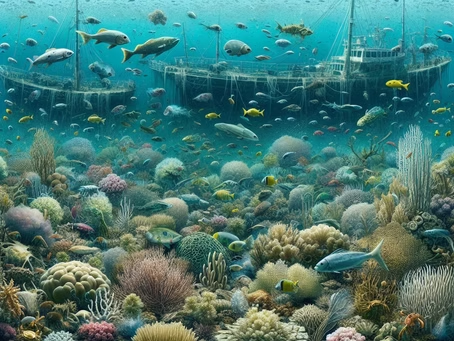The Fragile Web: How Overfishing Unravels Marine Ecosystems
Beneath the ocean’s surface lies an intricate network of life where every species plays a crucial role. Marine food webs represent nature’s perfect balancing act—complex systems where microscopic plankton support massive whales and everything in between. When human activities like overfishing disrupt these delicate connections, the consequences ripple through entire ecosystems, threatening both marine biodiversity and human communities that depend on oceanic resources.
The Precarious Balance of Ocean Life
Marine ecosystems thrive on interdependence, where each organism contributes to the overall health and stability of the environment through carefully evolved relationships.
Keystone Species and Their Vital Roles
Certain species function as ecological linchpins, their presence critical to maintaining structural integrity within food webs. From sea otters controlling sea urchin populations to sharks regulating mid-level predators, these keystone species prevent any single group from dominating and ensure biodiversity flourishes. Their removal can trigger catastrophic ecosystem shifts.
The Domino Effect of Species Depletion
When targeted fishing removes specific species at unsustainable rates, it creates vacuum effects throughout the food web. The loss of large predatory fish often results in population explosions of their prey, which then overconsume the next trophic level down. This trophic cascade can fundamentally alter ecosystem composition and function.
The Human Hand: Unsustainable Fishing Practices
Modern fishing techniques and economic pressures have created harvesting methods that far outpace nature’s ability to replenish marine life.
Beyond Overfishing: Bycatch and Habitat Destruction
The problem extends beyond simply taking too many target species. Non-selective fishing methods result in significant bycatch—the accidental capture and discard of non-target species including dolphins, turtles, and seabirds. Additionally, practices like bottom trawling physically destroy vital habitats like coral reefs and seagrass beds that support entire ecosystems.
Illegal and Unregulated Fishing
Despite international agreements and regulations, illegal fishing operations continue to plunder protected waters and species. These activities undermine conservation efforts and create unfair competition for legitimate fishers, further exacerbating the pressure on vulnerable fish stocks.
Cascading Consequences Through Ecosystems
The impacts of disrupted food webs extend far beyond the immediate fishing grounds, affecting both marine and human systems.
Altered Predator-Prey Dynamics
With key predators removed, prey species experience population explosions that then overwhelm their own food sources. This can lead to the collapse of commercially valuable species and the rise of less desirable organisms, fundamentally changing the character of marine environments.
Habitat Degradation and Loss
Species that play important roles in maintaining habitat structure—such as parrotfish that clean coral reefs or filter feeders that maintain water quality—when diminished, contribute to the degradation of the physical environment. This habitat loss further reduces the ecosystem’s capacity to support diverse life.
Intersecting Threats: Climate Change and Fishing Pressure
Marine ecosystems face the dual challenges of direct human exploitation and broader environmental changes, with each exacerbating the other.
Compounding Stressors
Rising sea temperatures and ocean acidification create additional stress on species already weakened by overfishing. The combined impact of these pressures reduces the resilience of marine organisms, making them more vulnerable to diseases and less able to adapt to changing conditions.
Shifting Distributions and Mismatches
As climate change alters ocean conditions, species distributions shift, potentially creating mismatches in predator-prey relationships and disrupting the synchrony that has evolved over millennia. These changes further complicate already stressed food web dynamics.
Socioeconomic Ripple Effects
The consequences of disrupted marine food webs extend onto land, affecting communities and economies that depend on healthy oceans.
Threats to Food Security and Livelihoods
Coastal communities worldwide face economic instability and food insecurity as fish populations decline. The loss of traditional fishing opportunities forces difficult transitions while threatening cultural practices that have sustained these communities for generations.
The True Cost of Short-Term Gains
While overfishing may provide immediate economic benefits, the long-term costs—including fishery collapses, lost tourism revenue, and the expense of restoration efforts—far outweigh short-term profits. Sustainable management represents not just an ecological imperative but an economic necessity.
Pathways to Recovery: Conservation and Sustainable Management
Despite the challenges, well-designed interventions can help restore balance to marine food webs and protect these vital systems.
Implementing Ecosystem-Based Management
Moving beyond single-species management to approaches that consider the entire ecosystem allows for more effective conservation. This includes establishing marine protected areas, implementing catch limits based on scientific assessments, and reducing bycatch through improved fishing technologies.
The Power of Consumer Choice and Policy
Informed consumers can drive change by supporting sustainable seafood choices, while robust policy frameworks at local, national, and international levels create the structure needed for effective management. Combined with scientific research and monitoring, these approaches offer hope for restoring the balance of marine food webs.

